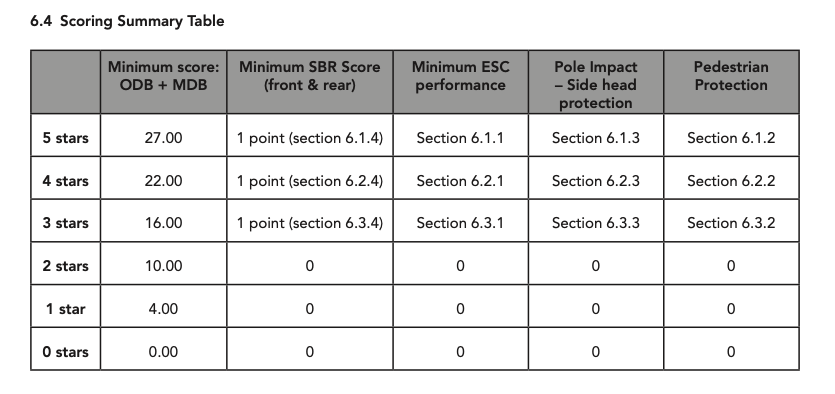The Fault in [The] Stars
- The Yawning Chihuahua
- Mar 25, 2024
- 3 min read
Updated: Mar 21

Global NCAP appear to have overlooked a loophole in their 2022-25 protocols that is not only penalising some cars for exploiting an advantage they couldn't possibly have claimed, but even inadvertently favouring cars with "consistent" crash protection in both crash tests -- even if that means "consistently poor".
GNCAP 101
To award a car a star rating, Global NCAP wants ALL requirements for the rating to be met: a minimum total crash score, and a bunch of other qualifying requirements. The protocol document summarises it well:

The troublesome clause
"In order to avoid the indescribable [sic] situation of a vehicle performing very poorly in the frontal or side tests, with a difference of scores in front and side above 35%, the car will have its Adult star rating reduced by one star to show that do not provide similar good all-around protection." — Global NCAP's new protocol (section 6.4.2)
Global NCAP is presumably trying to address poorly engineered vehicles that just gather a few points in the frontal impact test, and full marks in the side impact, eg. by virtue of their inherent height, to collect "easy" stars.
The problem?
(I'm lazily using the quote function to make this prominent:)
Global NCAP understandably deletes a star for imbalance in front and side crash scores — but not from the 'crash' part of the rating as it should have been; instead, from the final rating after considering extras like ESC, pedestrian protection and other 'caps' on the star rating.
So, coming to the Citroen ë-C3.

The ë-C3's 'POOR' chest protection did not send it straight to 0 points and zero stars — the kind of thing usual in 0-star cars, which happens when a dummy reading indicates an unacceptably high risk of serious injury. Rather, the ë-C3 was 'capped' at one star because chest protection fell into the 'POOR' band only after an additional penalty for high loads from the seatbelt.
Yes, it's not a good result by any means, but did the ë-C3 still need to lose a star because of a high side impact score, when there was no way it could have "unfairly" improved the star rating anyway?
Did the ë-C3 still need to lose another star for having a high side impact score, when there was no way that could have "unfairly" improved the star rating anyway?
The loophole
Get this — if Stellantis want to "upgrade" the Citroën ë-C3 from 0 to 1 star, all they need to do is WORSEN its side impact protection.
That way, it does not lose its one star — and it has a comfortable 16-point buffer to spare before it falls below the minimum 4 points required to qualify for a one-star rating.
As long as the star rating is limited by some factor that does not affect the total crash score, cars with consistently poor protection are favoured over those with mixed protection
Example
In case you're in doubt, this has actually already happened before, with the Maruti Suzuki S-PRESSO. Its frontal impact is nearly as bad as the ë-C3's, save for a slightly better lower leg score, and just like in the ë-C3, a 'POOR'ly protected chest capped the result at 1 star. But its side impact score of 11.9 is close enough to its low frontal impact score that it can keep its one star!

One star for what, consistency?
It doesn't take a genius to see the problem with that!







Comments